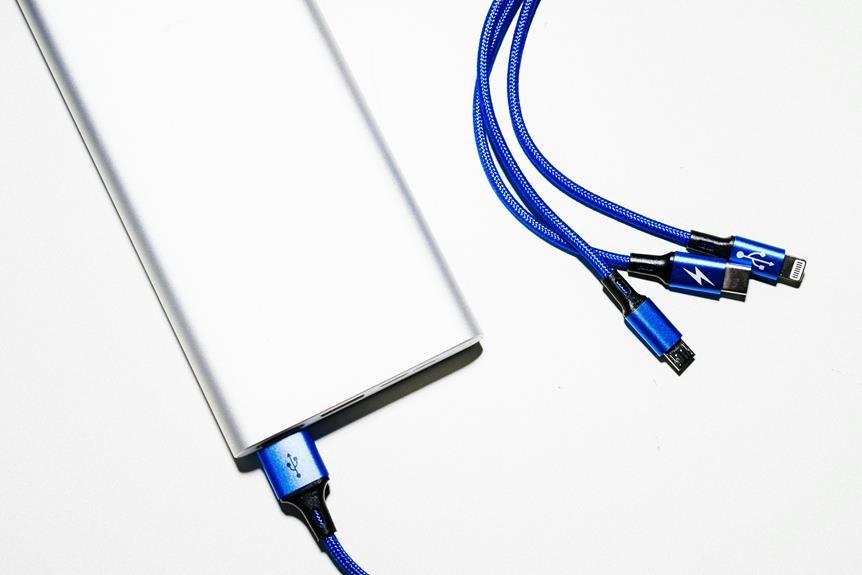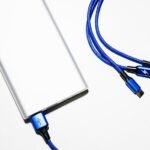To charge a solar power bank, place it in direct sunlight for 5-6 hours daily to harness peak energy. Optimize efficiency by positioning at a 30-45 degree angle and avoiding shaded areas. During cloudy or rainy weather, use USB ports with higher amperage for consistent charging. Keep the device clean to guarantee maximum energy absorption. Avoid overcharging and fully discharging to prolong battery life. These steps secure your solar power bank charges effectively and lasts longer. For more advanced tips and technical insights, continue exploring these guidelines.
Understanding Solar Power Banks
In today’s tech-driven world, understanding solar power banks involves grasping their energy conversion effectiveness and storage capacity metrics. When you’re evaluating a solar power bank, pay close attention to the battery capacity, typically measured in milliamp-hours (mAh). High-capacity batteries, like those above 20,000 mAh, can store more energy, allowing you to charge devices multiple times before needing a recharge. However, larger battery capacities often mean longer charging times and potentially a heavier device.
Portability features are another essential aspect. If you’re always on the move, you’ll want a lightweight, compact design. Look for models with integrated solar panels that fold out to maximize surface area without adding bulk. Some advanced units even offer detachable panels, increasing flexibility. A power bank should also have durable materials that can withstand harsh environments, ensuring longevity and reliability.
Efficiency rates, often around 15-20%, indicate how well the device converts sunlight into usable energy. Higher efficiency means faster charging, important for maintaining your freedom to explore. Balancing battery capacity and portability features ensures you have a reliable power source, whether you’re hiking, camping, or simply avoiding the grid.
Selecting the Right Location
To maximize efficiency, place your solar power bank in a location with best sunlight exposure, ideally receiving at least 5-6 hours of direct sunlight per day. Avoid shaded areas, as even partial shading can reduce charging efficiency by up to 80%. Additionally, consider weather conditions; overcast skies can greatly decrease energy absorption, so plan accordingly.
Optimal Sunlight Exposure
Maximizing the effectiveness of your solar power bank requires placing it in a location where it can receive direct sunlight for the majority of the day, guaranteeing unobstructed exposure from dawn until dusk. This strategic positioning enhances solar panel efficiency, enabling the device to convert sunlight into electrical energy more efficiently. To achieve best sunlight exposure, select a location with a high solar insolation value, ideally between 5 to 6 kWh/m²/day. This measurement quantifies the potential energy your solar panels can harness within a specific area daily.
Assessing the geographical orientation is vital. Position the solar power bank to face true south in the Northern Hemisphere or true north in the Southern Hemisphere for maximum sunlight capture. Consider the tilt angle as well; an angle equivalent to your latitude plus 15 degrees during winter or minus 15 degrees during summer is recommended to optimize solar panel efficiency.
High battery capacity ensures prolonged energy storage, essential for maintaining device functionality when sunlight is intermittent. For example, a 20,000mAh battery can store enough energy to charge multiple devices. By carefully selecting the right location, you can achieve freedom from electrical constraints, enjoying uninterrupted power supply wherever your adventures lead.
Avoid Shaded Areas
When choosing a location for your solar power bank, make sure it’s free from shade to maintain peak energy conversion efficiency. Even partial shading can greatly reduce the performance of your solar panels. For example, a shaded area covering just 10% of the panel can decrease its efficiency by up to 50%, significantly impacting the overall charging time.
Optimal solar panel efficiency is vital for maximizing the energy absorbed and stored in your power bank’s battery. To achieve this, make sure the solar panels are placed in an area that receives uninterrupted sunlight for the longest duration possible. Avoid placing the panels near objects that might cast shadows, such as trees, buildings, or other obstructions.
Battery capacity is directly affected by how much sunlight the panels can convert into usable energy. If the panels are not exposed to enough sunlight, the battery won’t reach its full charge, limiting the power bank’s effectiveness. This is especially important if you’re depending on the power bank for extended periods off-grid, where reliable energy storage is necessary for sustaining your devices.
Consider Weather Conditions
Considering weather conditions is vital for selecting a location that guarantees your solar power bank operates at peak efficiency. First, identify areas that receive direct sunlight for most of the day. Solar panels convert sunlight into electrical energy, and any obstruction can greatly reduce this conversion rate.
On cloudy days, efficiency drops significantly; solar panels still function but at a reduced capacity, typically producing only 10-25% of their rated power output. As a result, it’s important to monitor weather forecasts and plan charging sessions during clear days to maximize energy absorption.
In conditions of rainy weather, charging becomes even more challenging. Not only is sunlight obscured, but moisture can also pose a risk to the equipment. Make sure that your solar power bank is weatherproof or adequately protected from water ingress to avoid damage. Modern solar power banks often come with IP ratings that indicate their resistance to water and dust, so choose one that suits your typical environment.
Adhering to these guidelines will optimize your solar charging experience, ensuring that you harness as much solar energy as possible, regardless of the weather variations. This approach empowers you to maintain a reliable, renewable energy source, no matter where your adventures take you.
Positioning for Maximum Sunlight
To optimize your solar power bank charges efficiently, position it at an angle that directly aligns with the sun’s rays, typically between 30-45 degrees. Avoid shaded areas, as even partial shading can reduce energy absorption by up to 80%. Be mindful of seasonal changes in sun exposure, adjusting the angle and location as necessary to optimize sunlight capture.
Optimal Sunlight Angles
Positioning your solar power bank at an angle of about 30 to 45 degrees relative to the sun’s rays maximizes energy absorption and efficiency. Ensuring ideal sunlight angles significantly improves solar panel efficiency, allowing your power bank to charge more rapidly and effectively. Angle adjustments are vital because the angle of incidence—the angle at which sunlight strikes the panel—directly affects energy conversion rates.
To achieve the best results, consider the following:
- Geographic Latitude: Align the angle of your solar power bank with your latitude. For maximum efficiency, tilt the panel at an angle equal to your geographic latitude for peak year-round performance.
- Seasonal Variations: Adjust the angle seasonally. During winter, increase the tilt by 15 degrees, and during summer, decrease it by 15 degrees to accommodate the sun’s changing path.
- Time of Day: Position your solar power bank to face the sun directly during peak sunlight hours, typically between 10 AM and 2 PM.
- Fixed vs. Adjustable Mounts: Utilize adjustable mounts for more precise angle adjustments and fixed mounts when frequent repositioning isn’t feasible.
Avoiding Shaded Areas
Maximizing energy absorption not only involves optimizing the angle but also requires making sure your solar power bank is placed in areas free from any shade. Shaded areas dramatically reduce solar panel efficiency, which in turn decreases the overall charging speed and effectiveness. Even partial shading can cause a significant drop in performance. For instance, a mere 10% shading can reduce power output by up to 50%, making it essential to position your device correctly.
To achieve maximum sunlight exposure, place your solar power bank in open areas away from trees, buildings, or any obstructions that could cast shadows. Consider the solar panel’s orientation; facing it directly towards the sun will enhance its efficiency and optimize energy capture. This practice ensures the battery capacity is replenished at the highest possible rate, providing you with a more reliable power source.
Seasonal Sun Exposure
Understanding seasonal variations in sunlight is essential for optimizing the placement of your solar power bank to maximize energy absorption throughout the year. Seasonal shifts impact both the solar panel orientation and sunlight duration, requiring careful consideration to guarantee efficiency.
During the winter months, the sun is lower in the sky, and daylight hours are shorter. Adjusting the tilt angle of your solar panel to a steeper angle can capture more direct sunlight. Conversely, in the summer, the sun is higher, and a shallower angle is more effective.
Consider these key factors:
- Solar panel orientation: Align your panel towards the equator. In the Northern Hemisphere, face it south; in the Southern Hemisphere, face it north.
- Sunlight duration: Track the daily sunlight hours in your location. Use this data to position the panel where it will receive the maximum amount of light.
- Shading patterns: Seasonal foliage changes can create unexpected shadows. Regularly check for new obstructions.
- Temperature effects: Extreme temperatures can impact efficiency. Ensure sufficient ventilation to avoid overheating.
Charging With USB Ports
Charging a solar power bank via USB ports can offer a reliable and efficient alternative when sunlight isn’t readily available. This method guarantees you can maintain your device’s charge without depending on solar panel efficiency, which can vary due to weather conditions. Understanding the USB charging parameters is vital for optimizing charging time and securing your power bank’s longevity.
When using USB ports, consider the output power of your USB source. Most standard USB ports provide 5V at 1A, but high-speed charging ports can offer 2A or more. The charging time will depend on the power bank’s capacity and the USB port’s output. Here’s a table outlining typical charging times:
| Power Bank Capacity (mAh) | USB Port Output (A) | Estimated Charging Time (hours) |
|---|---|---|
| 5,000 | 1 | 5 |
| 5,000 | 2 | 2.5 |
| 10,000 | 1 | 10 |
| 10,000 | 2 | 5 |
| 20,000 | 2 | 10 |
Using a higher amperage USB port can greatly reduce charging time. Keep in mind that while solar panel efficiency is essential for outdoor use, USB charging provides a consistent and controllable power source. Balancing between solar and USB charging ensures you’re always powered up, no matter the circumstances.
Maintenance and Care
Proper upkeep and care of your solar power bank are vital to guaranteeing its best performance and longevity. When it comes to cleaning suggestions, use a soft, damp cloth to wipe the surface, avoiding abrasive materials that could scratch the solar panels. Keep the panels free from dust and debris to maintain peak energy absorption.
To maximize battery care, avoid fully discharging the power bank frequently, as this can reduce battery lifespan. Charge it when it drops to around 20-30% capacity. Be mindful of overcharging risks; most modern solar power banks have built-in protection, but it’s always a good practice to disconnect once fully charged.
Storage precautions are optimal to maintain efficiency. Store your solar power bank in a cool, dry place. Avoid extreme temperatures, which can degrade battery performance.
Here are some additional maintenance tips:
- Avoid prolonged exposure to direct sunlight: While it’s designed for solar charging, excessive heat can damage the battery.
- Check for firmware updates: Some models allow firmware upgrades to enhance performance.
- Inspect regularly for damage: Look for cracks or frayed wires.
- Use original accessories: Always use the provided cables and chargers for compatibility and safety.
Applying these practices ensures your solar power bank remains a dependable energy source, empowering your freedom to explore without limitations.
Troubleshooting Common Issues
Encountering issues with your solar power bank can often be attributed to common problems that are easily diagnosable and fixable. A frequent concern is battery life, which can degrade due to improper usage or environmental factors. If you notice diminished capacity, make sure the power bank isn’t exposed to extreme temperatures. Overheating concerns also arise, especially if the device is left in direct sunlight for extended periods.
Below is a table outlining common issues and their respective solutions:
| Issue | Solution |
|---|---|
| Diminished Battery Life | Avoid exposing to high temperatures. Charge fully before first use. |
| Overheating | Keep the power bank in shaded areas while charging. |
| Slow Charging | Ensure solar panels are clean. Position panels directly under sunlight. |
| No Power Output | Check the connection and confirm the device is compatible. |
For best battery life, use the power bank regularly and charge it every few months if stored. Always monitor for overheating concerns by feeling the device’s temperature periodically. If it becomes too hot, disconnect it immediately and let it cool down in a shaded area. By following these guidelines, you’ll maintain the efficiency and longevity of your solar power bank, ensuring uninterrupted freedom in your adventures.
Frequently Asked Questions
How Long Does It Take to Fully Charge a Solar Power Bank?
Charging a solar power bank could take an eternity, but realistically, it depends on solar power bank efficiency and charging speed. Typically, expect 20-50 hours under direct sunlight, though higher efficiency models might be faster.
Can I Use the Solar Power Bank While It Is Charging?
Yes, you can use the solar power bank while it’s charging, but follow safety precautions to avoid overheating. Continuous usage may reduce battery life over time. Confirm that your device’s specifications support simultaneous usage and charging.
Are Solar Power Banks Waterproof or Weather-Resistant?
Solar power bank durability varies by model. Some feature advanced waterproofing technology, making them weather-resistant and ideal for outdoor use. Always check the manufacturer’s specifications to guarantee it meets your needs for freedom and resilience.
What Devices Can Be Charged Using a Solar Power Bank?
You’re probably wondering about solar power bank compatibility and charging efficiency. These banks can charge smartphones, tablets, cameras, and some laptops. Charging efficiency varies, but most devices with USB or DC input are compatible.
How Do I Know if My Solar Power Bank Is Charging Correctly?
To guarantee your solar power bank is charging correctly, check the charging indicator for consistent light signals. If issues arise, use troubleshooting tips like repositioning the solar panel for peak efficiency or verifying cable connections.



